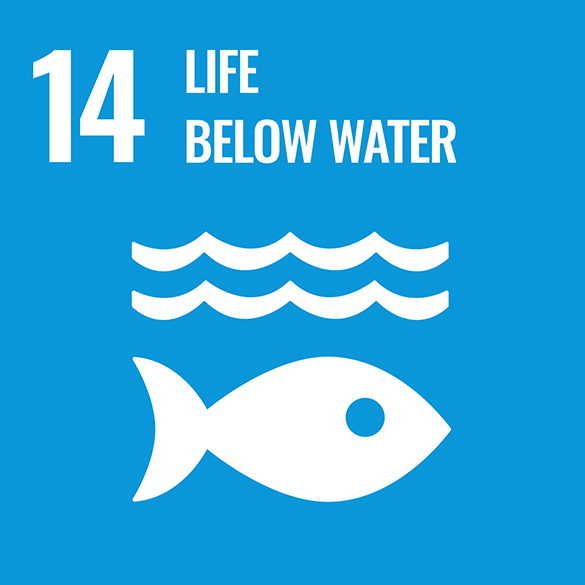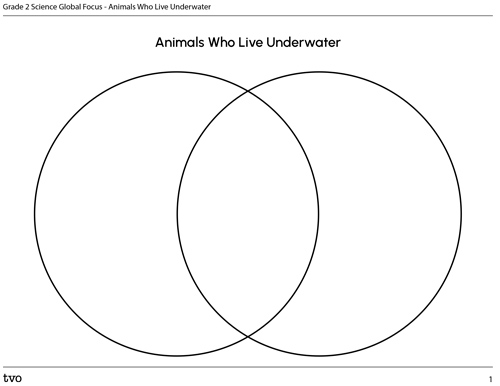Minds On
Connecting to the world

The United Nations (UN) is a group of many countries from around the world that have come together to create a better future for people and the environment. They have created 17 goals called the Sustainable Development Goals.
This learning activity is connected to Goal #14 which is called Life Below Water. This means everyone should help protect our oceans and seas.
Animals who depend on the world’s water for part of their lifecycle need help protecting where they live and grow.
How many different animals do you know that live underwater?
Share your ideas with a partner, if possible. Record your ideas using pictures, words, or as an audio description.
Action
Circle of life

An animal’s physical appearance changes throughout their life. In many cases, these changes can be considered a cycle.
A cycle happens when an event keeps repeating, like a pattern.
Animal life cycles
Let’s check out three animals and their cycles. As you explore the following animals, consider these questions:
- How are these animals similar?
- How are they different?
- What do you notice about how the animals change throughout their life cycles?
Share your ideas with a partner, if possible. Record your ideas using pictures, words, or as an audio description.
A frog’s life cycle is an excellent example of how an animal’s body changes and appears very different at each stage in the cycle. A frog depends on a healthy environment at all stages.
 Description
Description
This is the life cycle of a frog. The cycle begins with frog eggs in an egg mass. Then, a tadpole hatches from the egg and lives in the water. The tadpole will slowly start having legs. From there, the tadpole becomes a young frog with a tail. Afterwards, the frog becomes an adult frog with no tail. The cycle continues as the next female frog lays eggs to hatch.
Now, let’s explore the life cycle of a fish!
The whole life cycle of a fish exists only in water.
 Description
Description
This is the life cycle of a fish. The cycle begins with fish eggs. Then, they grow as an embryo, and slowly become baby fish. From there, the baby fish becomes a young fish, followed by an adult fish. The cycle continues as the next female fish lays the eggs.
A turtle’s life cycle is also very different in each stage. Turtles can live in and out of the water during the stages of their life cycle. Most turtle eggs are hatched on land near the water.
 Description
Description
This is the life cycle of a turtle. The turtle begins with turtle eggs. Then, a baby turtle hatches from the egg. The baby turtle slowly becomes a young turtle, and then an adult turtle. The cycle continues as the next female turtle lays the eggs.
Let’s code!
Coding is a series of steps or instructions used to model a concept. A flow chart is an example of unplugged coding. A flow chart can be used to show the sequence or steps of a cycle.
Place the following images in the correct order to show the life cycle of a frog.
The following cards are the different stages of a frog’s life cycle. Put the stages in each answer box in the correct order.
In the coding program, why do you think the frog’s life cycle shows the adult frog “going back” to eggs to start the cycle over again?
Record your ideas in a notebook or another method of your choice.
If possible, share your thoughts with a partner.
When you’re ready, press ‘Let’s Check!’ to access a possible answer.
The frog’s life cycle shows the adult frog “going back” to eggs to start the cycle, because the adult female frog will usually lay eggs containing the baby frogs. From there, the life cycle continues to a tadpole, a young frog, and then finally an adult frog.
Consolidation
Your turn!

In this activity, you have explored different animals that live underwater and the changes that happen throughout their life cycle.
Complete one of the following activities to share your learning.
Activity 1
Choose another animal that lives underwater or use an example from the Action section. Create your own flow chart to show the life cycle of the animal. You can draw, use a digital tool, or create a written or audio description. How will you show that the cycle repeats?
Activity 2
Choose two different animals that live underwater to compare. Use a Venn Diagram to describe how the two animals are different and how they are similar. Use the outside circles to write or draw about how they are different, and the inside circle to explain how they are similar.
Complete the Animals Who Live Underwater Venn diagram in your notebook or using the following document.

Press the Activity button to access the Animals Who Live Underwater.
Activity (Open PDF in a new tab)Share your work with a partner, if possible.
Reflection
How do you feel about what you have learned in this activity? Which of the next four sentences best matches how you are feeling about your learning? Press the button that is beside this sentence.
I feel…
Now, record your ideas about your feelings using a voice recorder, speech-to-text, or writing tool.